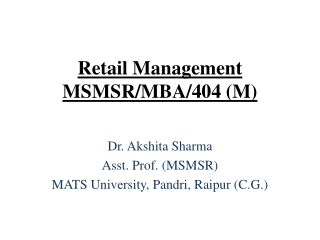Understanding Large Scale Retailing and Store Classification
Large scale retailing encompasses department stores, multiple shops, mail-order businesses, and super bazaars. It can be classified into store-based and non-store based retailing, further divided based on ownership and merchandise offered. Store-based retailers include independent retailers, chain retailers, and franchises, each with unique characteristics and management structures. Independent retailers are single owners operating one outlet, while chain retailers have multiple stores under common ownership. Franchises operate under a contractual agreement with a franchisor to conduct business under an established name. This overview delves into the merits, demerits, organization, and management of large-scale retailing businesses.
Download Presentation

Please find below an Image/Link to download the presentation.
The content on the website is provided AS IS for your information and personal use only. It may not be sold, licensed, or shared on other websites without obtaining consent from the author. Download presentation by click this link. If you encounter any issues during the download, it is possible that the publisher has removed the file from their server.
E N D
Presentation Transcript
Large Scale retailing- Department Store, Multiple Shop, Mail Order Business, Super Bazaar- Characteristics Merits & Demerits, Organization & Management.
Important categories under which the retail stores can be broadly classified are as follows: Retail stores can be broadly classified into two categories, i.e. store based retailers and non-store based retailers. A. Store based retailer: B. Non-Store Retailing:
Store based retailer is again classified I. On the basis of ownership: II. On the Basis of Merchandise offered
On the basis of ownership: 1. Independent retailer: An independent retailer is one who owns and operates only one retail outlet. Such stores can be seen under proprietorship. The individual retailer can easily enter into a retail market. The owner is assisted by local staff or his family members. These kinds of shops are passed from one generation to other generation. The independent retailer maintains a good relationship with the customers. Small scale retail business: Single owners can easily start and manage small business units profitably with the help of one or two assistants. It can be a grocery store, stationery shop, or a cloth store, etc.
On the basis of ownership: 2. A chain retailer: When two or more retail outlets are under a common ownership it is called a retail chain. For example: One of a number of retail stores under the same ownership and dealing in the same merchandise. It is called chain retailing. Chain Stores are groups of retail stores engaged in the same general field of business that operate under the same ownership or management, chain stores are retail outlets owned by one firm and spread nationwide. For example, Van Heusen, Food world, Shopper s stop etc.
On the basis of ownership: 3. Franchise: A franchise is a contractual agreement between franchisor and a franchisee in which the franchisor allows the franchisee to conduct a business under an established name as per the business format. In return the franchisee has to pay a fee to the franchiser. For example: Pizza hut, McDonalds, etc.
On the basis of ownership: 4. Leased Department: These are also known as Shop in Shops. When a section or a department in a retail store is rented to the outside party it is called leased department. The licensor permits the licensee to use the property and in turn the licensee pays a fee to the licensor for using his property. 5. Consumer Co-operatives: A consumer co-operative is a retail organisation owned by its member customers. The objective is to provide commodities at a reasonable price. For example: Sahakari Bhandar, Apna Bazaar etc.
II. On the Basis of Merchandise offered 1. Departmental Stores: 2. Convenience stores: 3. Super Market: 4. Hyper Market: 5. Specialty stores:

















































